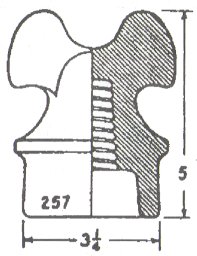Insulator Collecting 101
Reprinted from "Crown Jewels of the Wire", November 2003, page 7
One of the most popular insulator styles, shown here in a drawing from McDougald's Price Guide, is called
"the Mickey Mouse" after its
exaggerated cable groove.
"Mickey Mouse" insulators were made by the Hemingray Glass Company
for use in power lines carrying low voltages. The wire, or cable, that carried
the electricity rested in the cable groove at the top of the insulator. The
"ears" provided a means for tying the electrical wire to the insulator
with a smaller strand of wire called a "tie wire".

Thirty-five
different embossings have been found on CD 257's. Some of the older versions
are engraved with two patent dates. The date of June 17, 1890. refers to the
cable groove on top of the insulator, an invention by Samuel Oakman. The other
patent date is May 2, 1893, which refers to the Hemingray patent for drip
points.
Collector's fondly refer to a CD 257 insulator not only as a
"Mickey Mouse", but also as a "Mickey", or "Mouse
Ears", or sometimes just as a "Mouse".
Colors range from clear
glass, aqua, emerald green, many aqua and bluish shades, a number of two-tone
colorations, and a beautiful blue color collectors call "electric
blue."
Hemingray advertised the insulator in its catalogs as style #60, or 60-A. They were priced, in the 1920 catalog, at $140 per thousand. That's
14-cents
apiece. Today, dark electric blue specimens are valued at $1,750 each.
References:
Insulators Price Guide, by John & Carol McDougald, Box 21157,
Sedona, AZ 86341.
The Hemingray Glass Company, by H.G. "Bea" Hyve,
3269 N. Mountain View Dr, San Diego, CA 92116-1736
|
